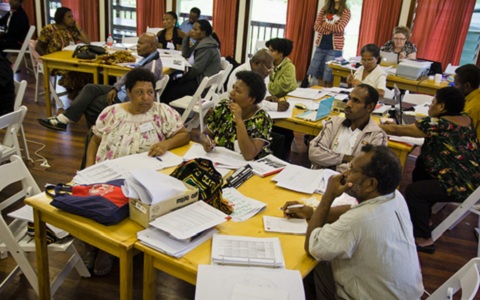What is it? Creative Phonics!
This reading method teaches basic units of sound in the vernacular language. Those sounds are combined to make words, and words quickly become sentences. The sounds are represented by local alphabets, including ones that have only recently been written.
SIL member Dr. Bob Litteral designed the Creative Phonics course because he saw the need for teaching reading and writing in communities with very limited resources. The steps for teaching phonics in the vernacular languages are laid out systematically, but the methods of presentation involve creativity. Teachers use local materials to write letters and phonemes. If paper and pencils are not available, they may write on leaves using clay and sticks, or form letters in the sand.
In October, 24 professors representing nine teacher colleges in Papua New Guinea met at the Ukarumpa Training Center. In three weeks they learned the Creative Phonics methods and were certified as Master Trainers. They left Ukarumpa, returned to their colleges, and each trained two to five others to lead the course. The colleges invited primary school teachers in their area to come to a Creative Phonics course.
By Christmas, these new trainers had taught 3,600 teachers throughout the country.
One of the teachers who attended was Sarah. She heard about the course being taught in Port Moresby, and wished she could go. When she learned that it was also being taught in her province of East New Britain, she took another teacher along with her and attended the class. Afterwards, Sarah was so excited about it that she started a workshop for teachers in her local area to train them in Creative Phonics methods as well.
SIL trainer Gertrude Nichols said, “There has been tremendous collaboration between SIL, the PNG Department of Education, principals of the teacher colleges, and the local teachers.” The result is hundreds of Papua New Guinean children in remote areas are learning to read in their mother tongue using this simple, practical method.


